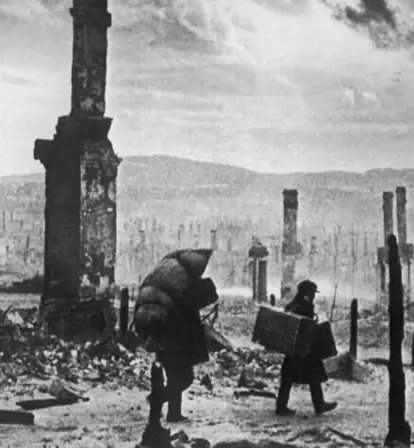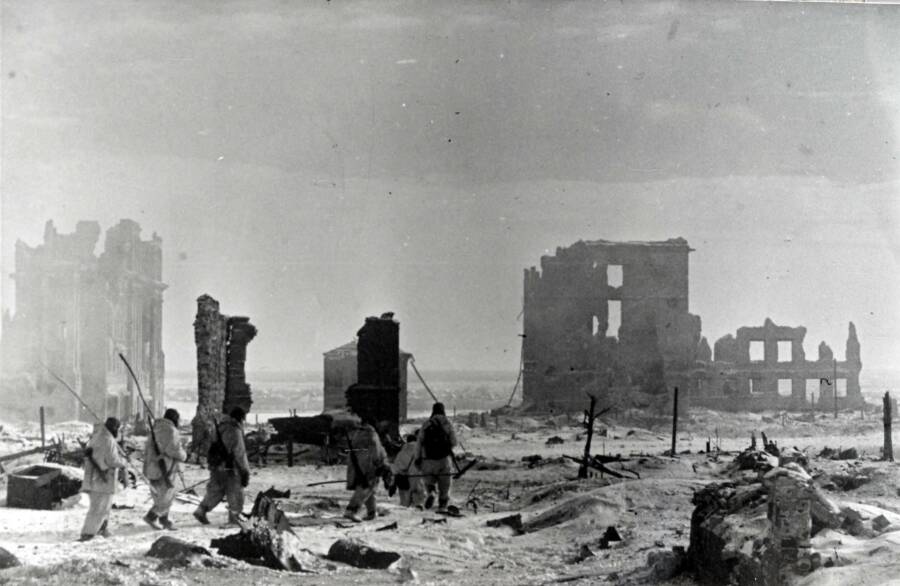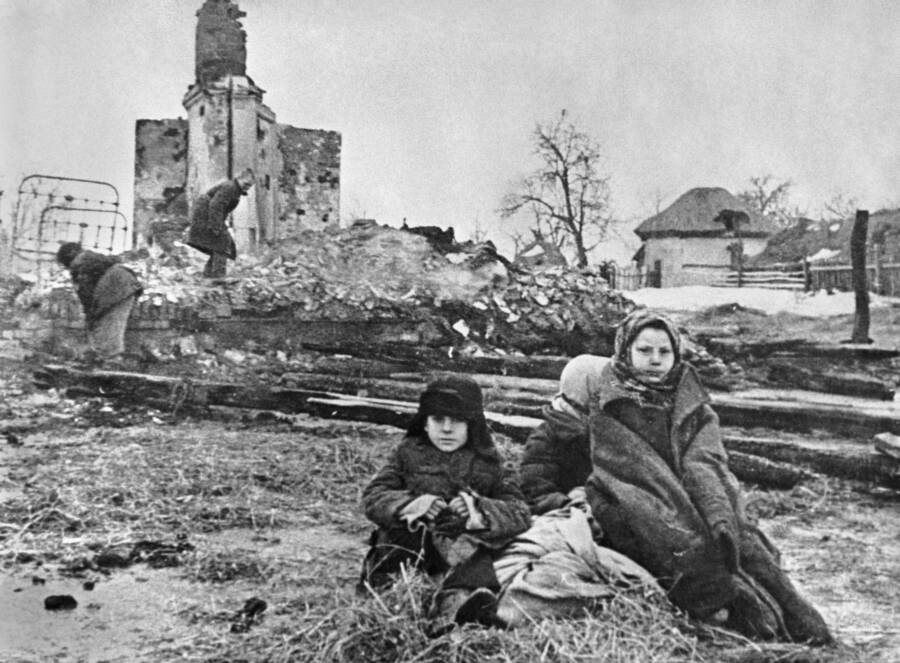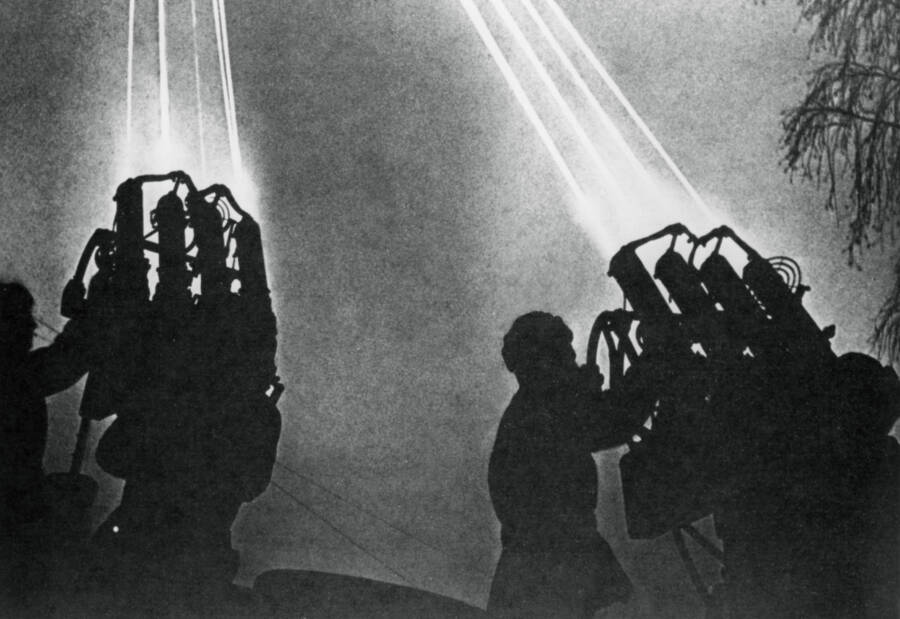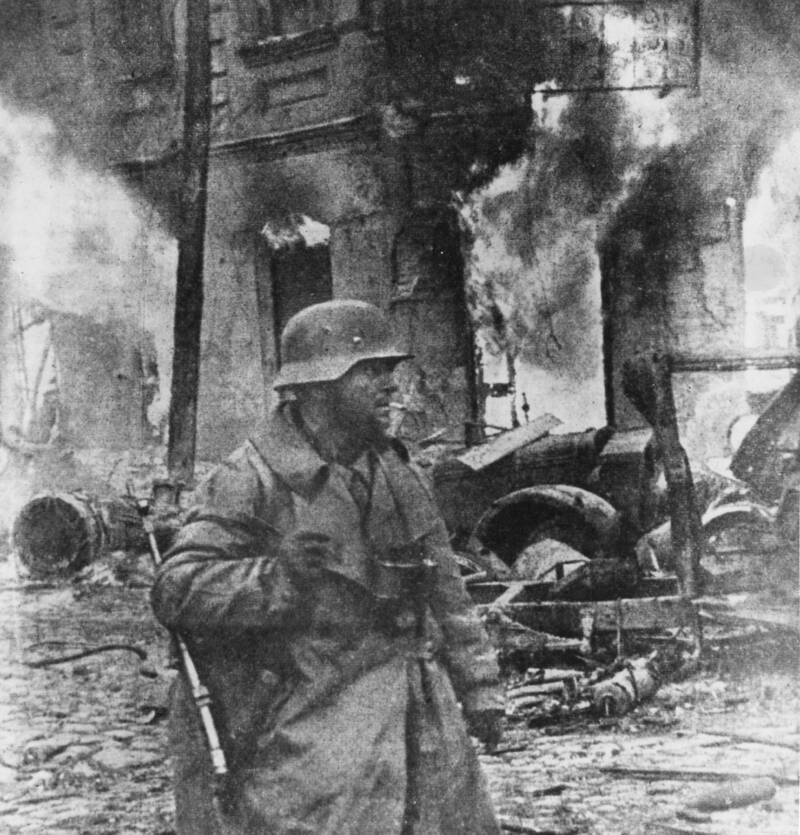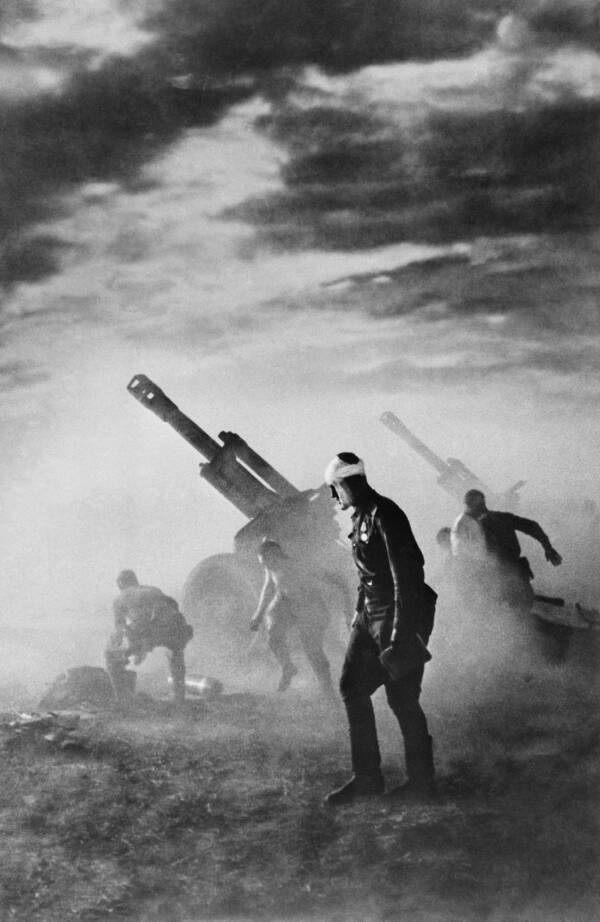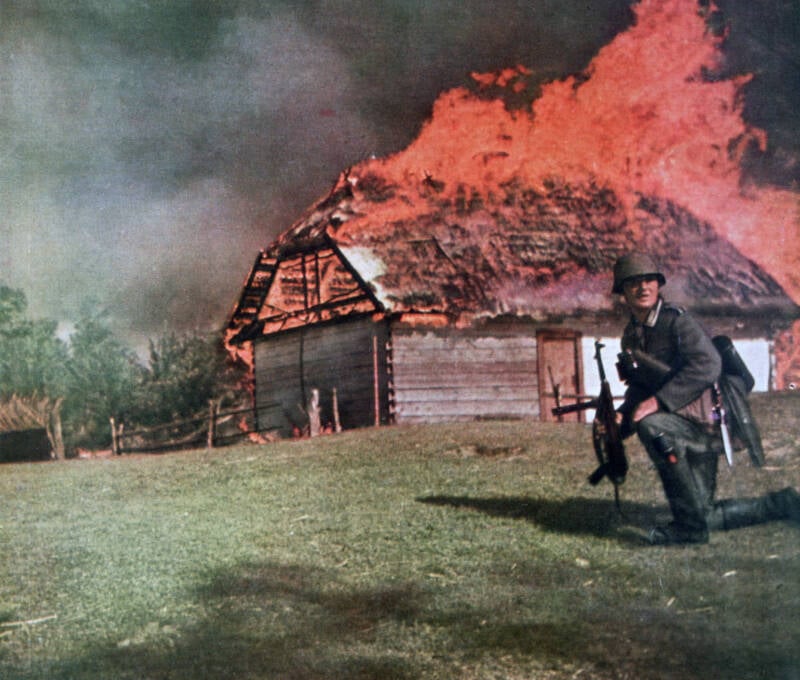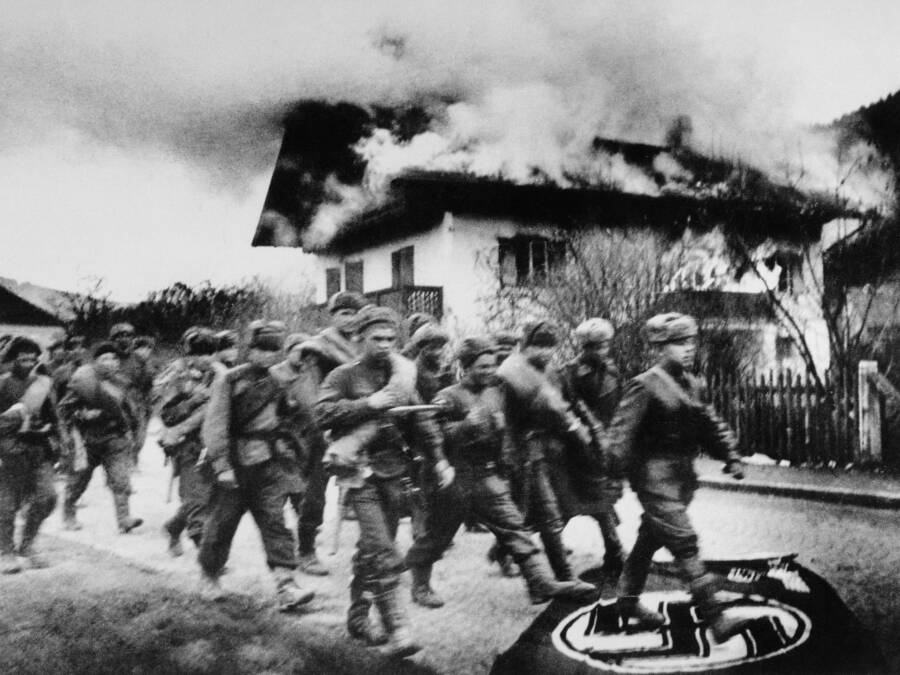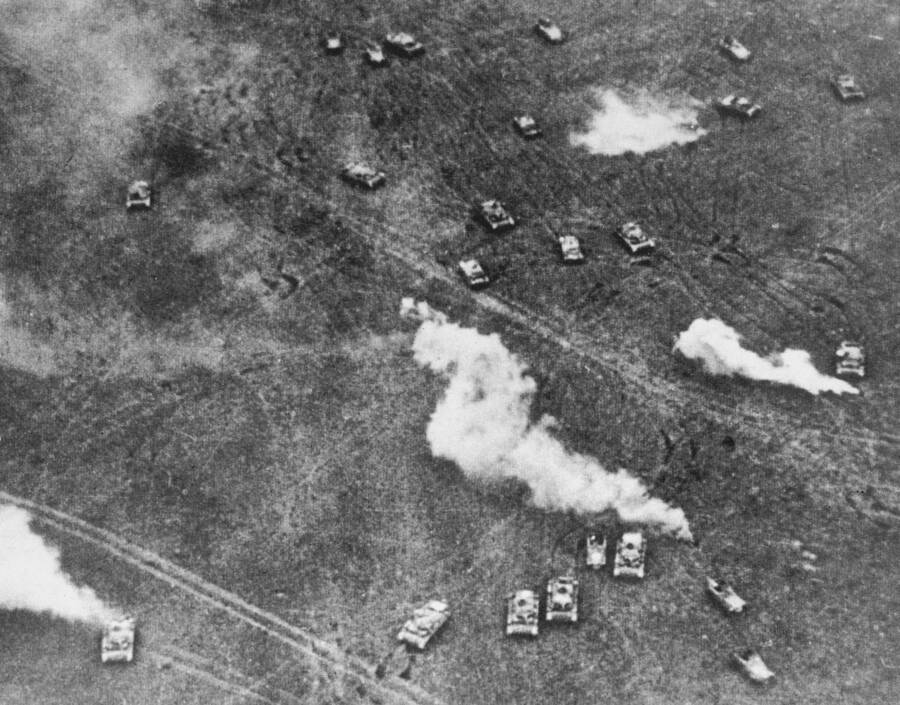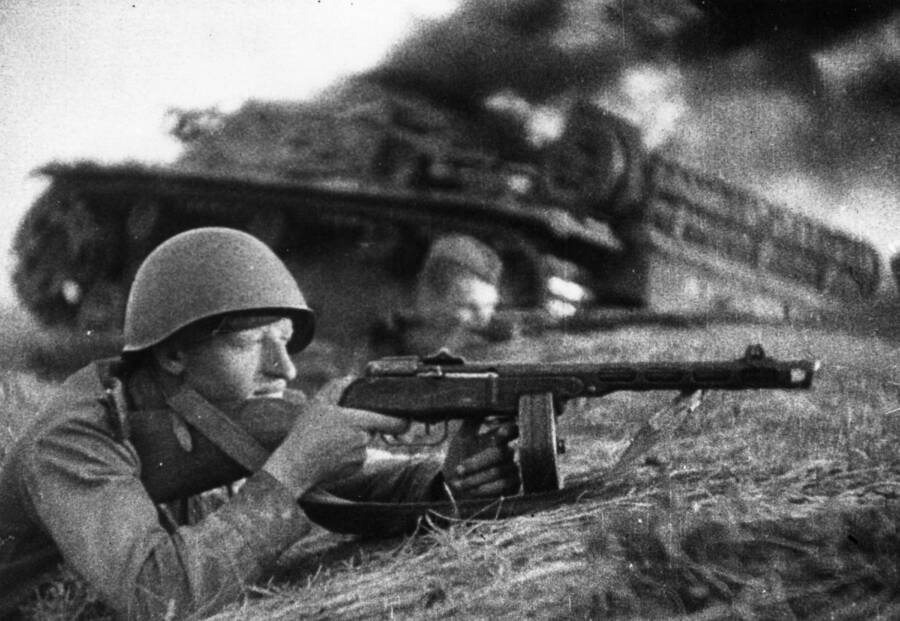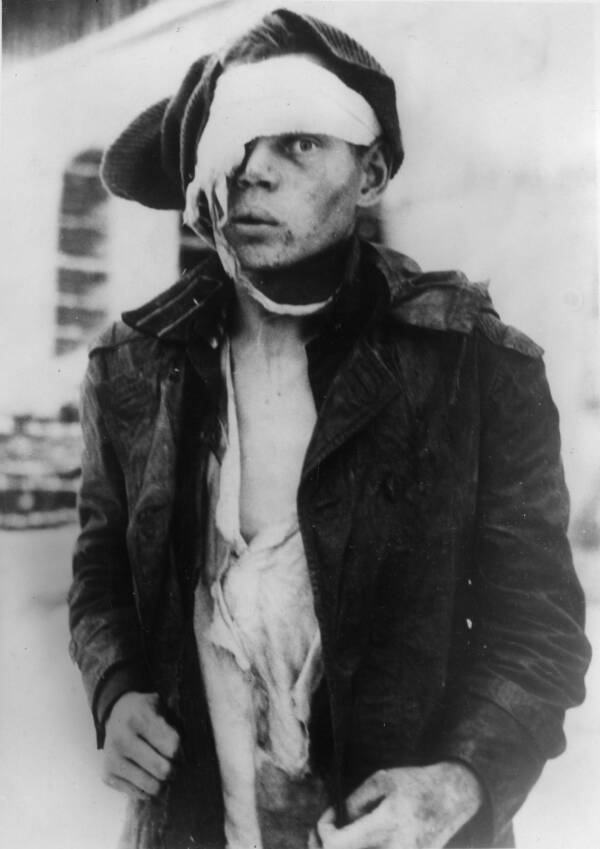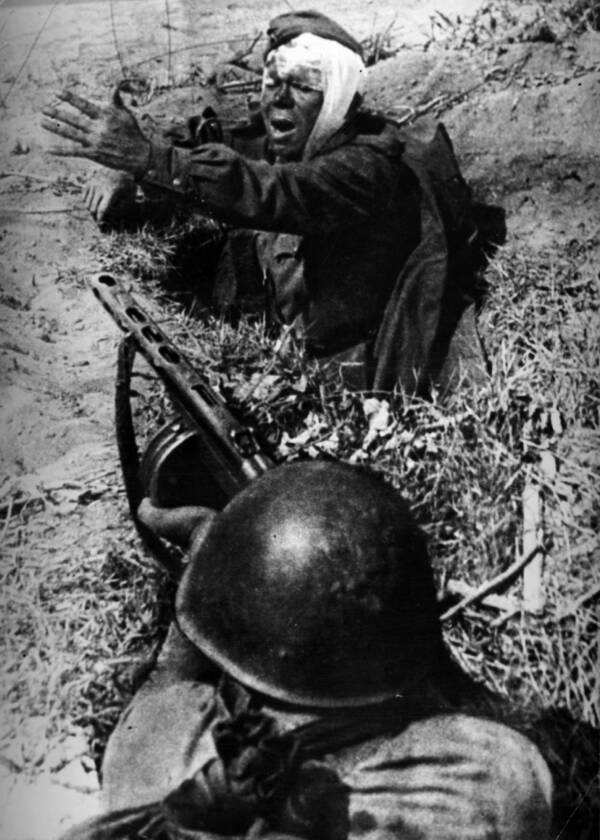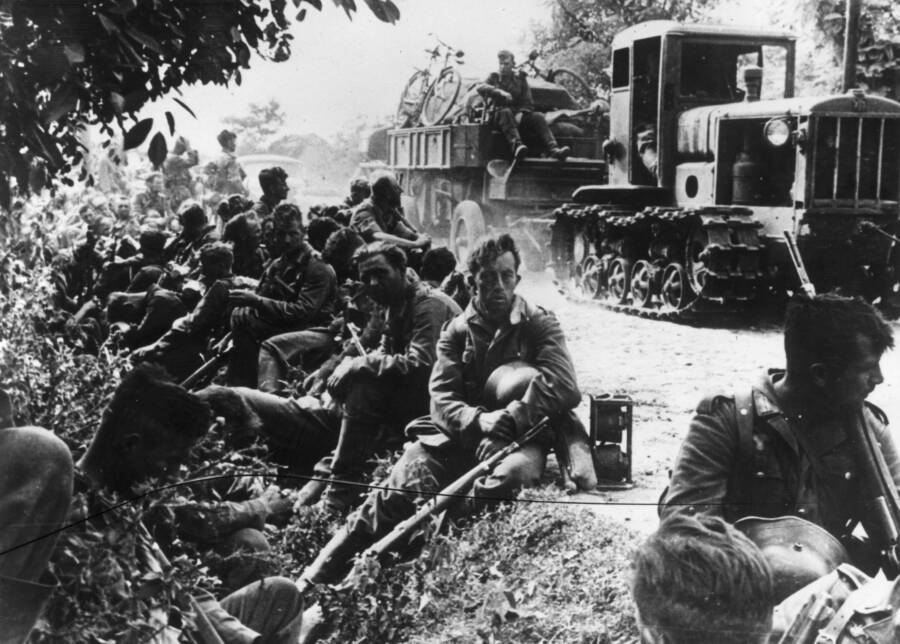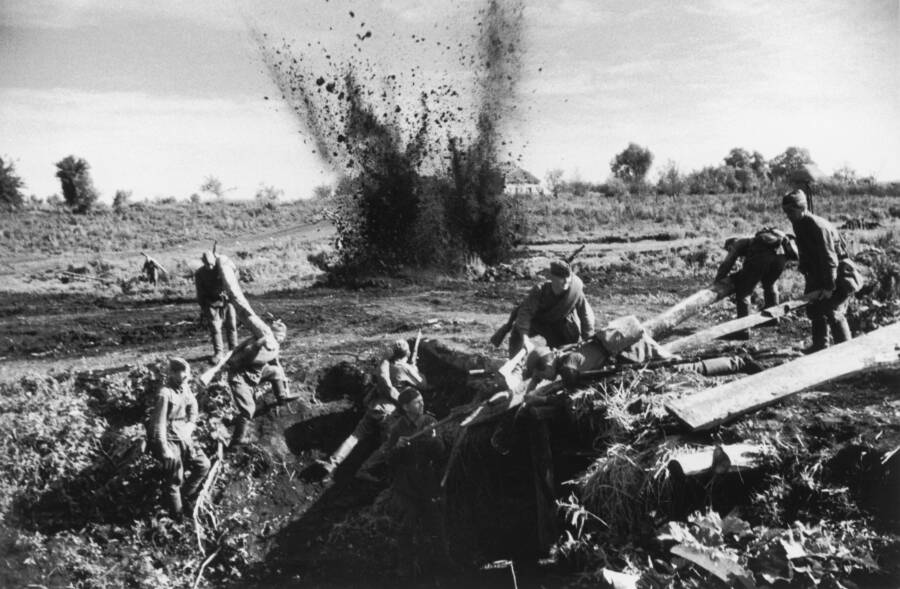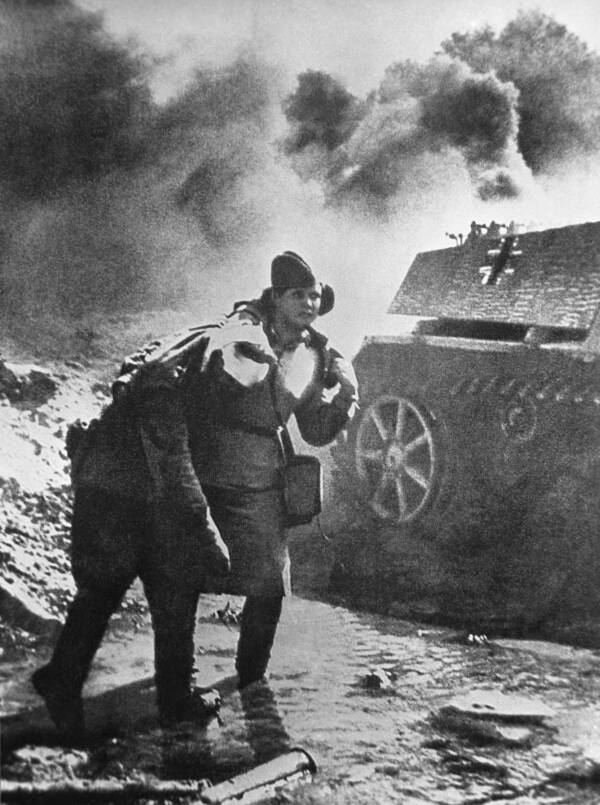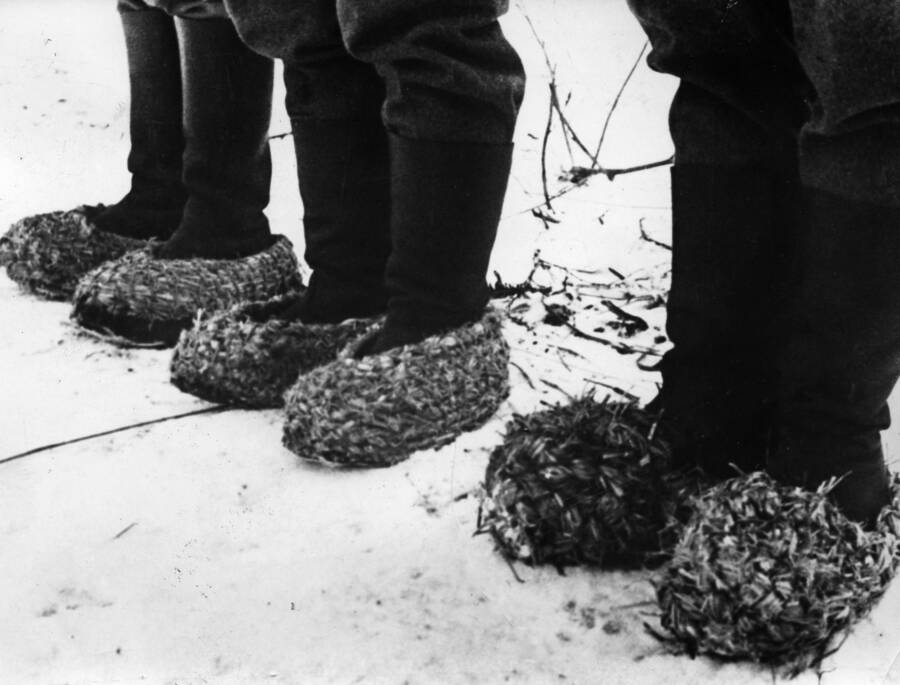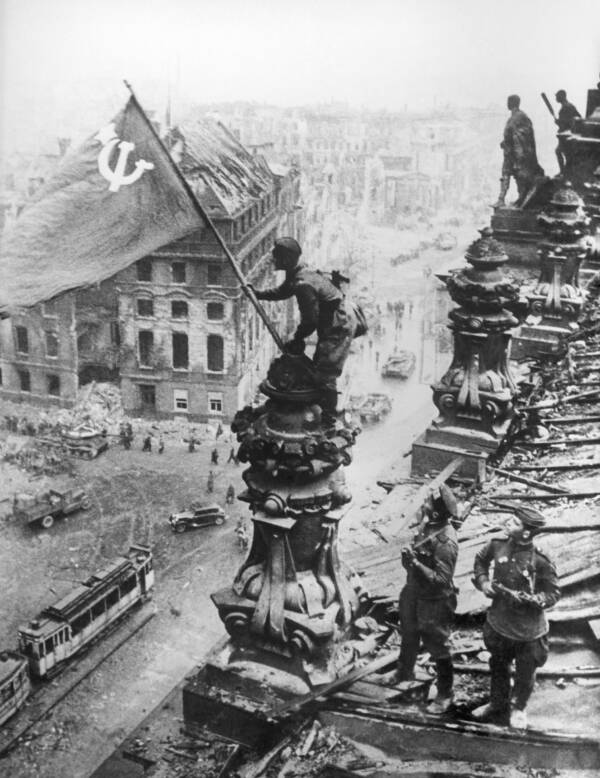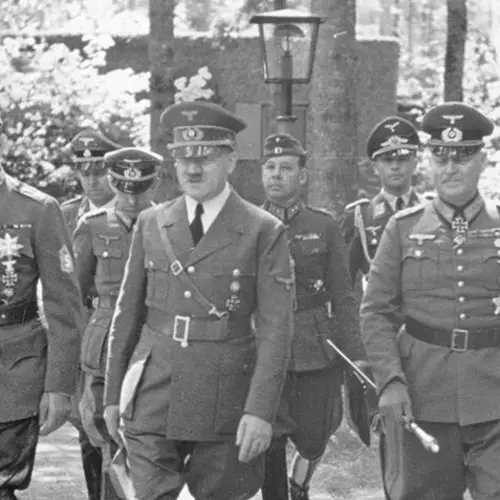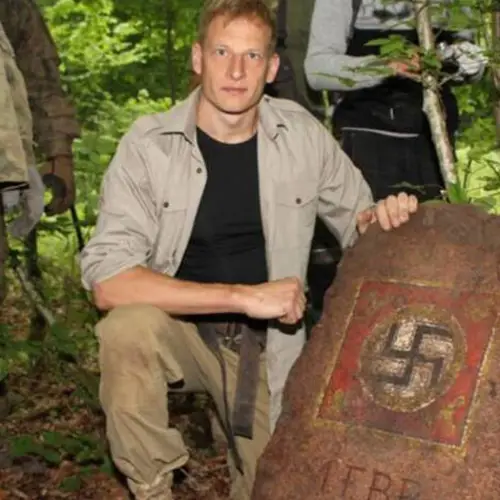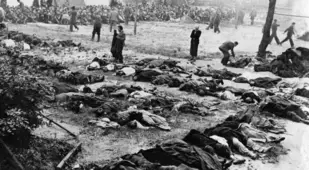The Nazis suffered 80 percent of their casualties on World War II's Eastern Front, the deadliest theater in the history of war.
World War II was won on the Eastern Front.
In the West, when we think of the end of the Second World War, we think of soldiers storming the beaches of Normandy on D-Day or the nuclear bombs falling over Hiroshima and Nagasaki.
But when the Nazi army fell, their greatest losses came from the Soviet Union in the easter – more than 80 percent of Germany’s military deaths in World War II occurred on the Eastern Front.
It was a battleground that saw more deaths than any other in history. Throughout the war, between 22 and 28 million Soviets lost their lives. As many as 14 million of them were civilians.
It was horrific — a theater of war the Nazis learned to dread — and a part of the battle that, because of the animosity between the U.S. and the Soviet Union after the war, has been all but completely scrubbed out of our history books.
Hitler’s Hatred Of The Soviet Union
“Everything I undertake is directed against the Russians,” Adolf Hitler admitted, days before his invasion of Poland started World War II.
He’d hated them since the moment Vladimir Lenin took power. In his 1925 manifesto Mein Kampf, Hitler declared that Russians were inferior beings, irreparably contaminated by Jews. The only use he saw in them was as a conquered people. Germany, he wrote, needed living space to survive, and the best way to get it was to capture the massive expanse of land that was in the east.
The Soviet Union was the target from the start, even when Hitler signed the Molotov-Ribbentrop Pact in August 1939, the treaty of non-aggression that declared neither Germany nor the Soviet Union would fight the other for 10 years. The Soviets would be allowed to invade Lithuania, Estonia, Latvia, and the eastern half of Poland, while Germany could invade Poland’s western half without fear of reprisal from the U.S.S.R.
Hitler had a plan, one he’d outlined behind closed doors to his confidants before he even signed the pact. He would make a deal with the Soviets, crush the Western powers, and then turn on the Soviet Union with all of his might.
By June 22, 1941, Hitler had already conquered most of western Europe. America had not yet officially entered the war and Britain alone stood in the path of total conquest. The time, Hitler believed, was right.
Without warning or any provocation, the armies of the Third Reich turned on their neighbors to the east.
The Eastern Front of World War II — and the beginning of Hitler’s downfall — had begun.
Operation Barbarossa Opens Up The Eastern Front Of WW2
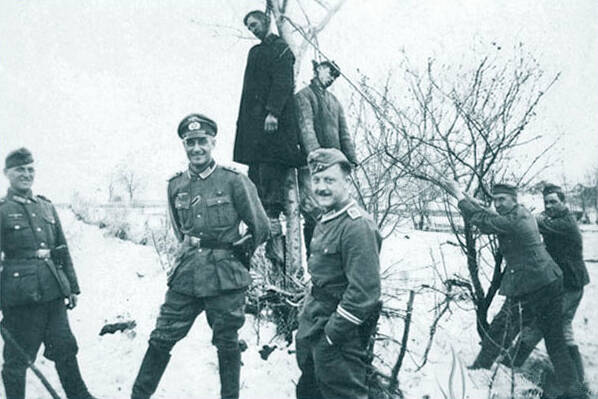
Flickr/Public DomainGerman soldiers smile in front of the the Soviets they just hanged from a tree during Operation Barbarossa. 1941.
“We have only to kick in the door and the whole rotten structure will come crashing down!” Adolf Hitler promised his men shortly after they’d begun marching into Soviet territory.
In the early days of the Eastern Front, it certainly must have seemed like his prediction would come true. The Nazis’ surprise attack, dubbed “Operation Barbarossa,” caught Stalin almost completely off guard.
The Nazi strategy was fast and one modeled on the blitzkrieg tactics they’d used in Poland. They cut the Soviets’ communications, bombed their airfields before Soviet planes could even get off the ground, and surprised them with an all-out assault that included more than half of the German Army.
Nazi panzer, or armored tank, forces would encircle pockets of Soviet troops, blocking any method of escape until the Nazis’ infantry was in place to finish them off. Then the panzer forces would go off and trap the next group while the infantry slaughtered them like trapped animals.
Stalin’s army could do nothing but run for their lives. The Red Army fell back, giving up whole countries to the Nazi Army as they scrambled to find a safe place to fight back.
All the Soviets could do to slow their enemy was to scorch the earth behind them. Villages, schools, and buildings were burnt to the ground as the Red Army fled, trying to leave nothing of value behind for the Nazis to take.
More often than not, civilians were left to fend for themselves. With their villages burned to the ground, they would have to trudge across the country themselves, praying to reach some safer land before Hitler’s army caught them.
Nazi Atrocities On The Eastern Front
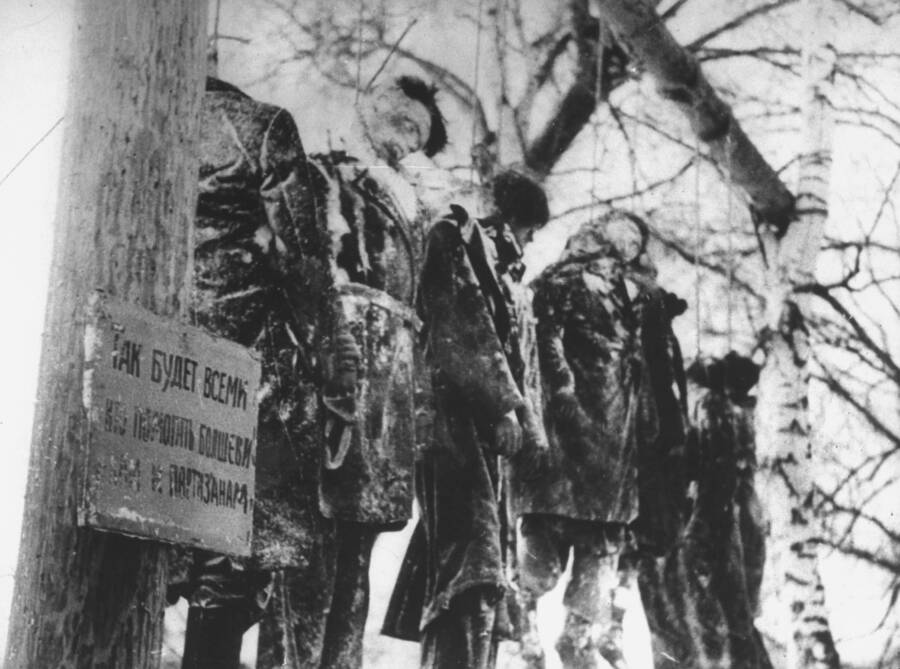
Time Life Pictures/Pix Inc./The LIFE Picture Collection/Getty ImagesBodies of members of the 8th Muscovite Young Communist League hanged by German troops. The sign reads: “This will happen to all those who help the Bolsheviks and guerilla fighters.” USSR. Circa 1941-1944.
Soldiers weren’t the only ones who died on the Eastern Front of World War II. Hitler had no interest in keeping the people of the Soviet Union safe. Anyone left behind when the Third Reich reached their village forfeited their lives.
The Nazi army routinely rounded up villagers and massacred them. An entire Schutzstaffel (SS) unit called the Einsatzgruppen was sent after the front lines of the army to round up Jews, Roma, Communists, and other racial and political enemies and slaughter them via mass shootings.
This wasn’t a few soldiers gone mad — it was four battalions of elite SS officers following orders from the high command.
Shortly after the invasion began, Hitler appointed Erich Koch as the Reichskommissar of the Commissariat of Ukraine, specifically choosing him because he knew he would be merciless to their civilians.
“I am known as a brutal dog,” Koch boasted in his inauguration speech, in front of a gathering of Nazi officials. “I am expecting from you the utmost severity toward the native population.”
The slightest sense of humanity could lead to punishment. When one German tried to set up a school system for Ukrainian youth, Koch cracked down on him, telling him that his only duty toward the civilians was to “annihilate the Ukrainians.”
Those who weren’t killed were often starved to death. Their towns were burnt to the ground, their farms captured and used to feed the German invaders, and the people left behind slowly withered away.
It was a horrific slaughter on an unprecedented scale. By the end of the war, more than 22 million Soviet citizens would be dead, most of whom were civilians.
The Winter Offensive
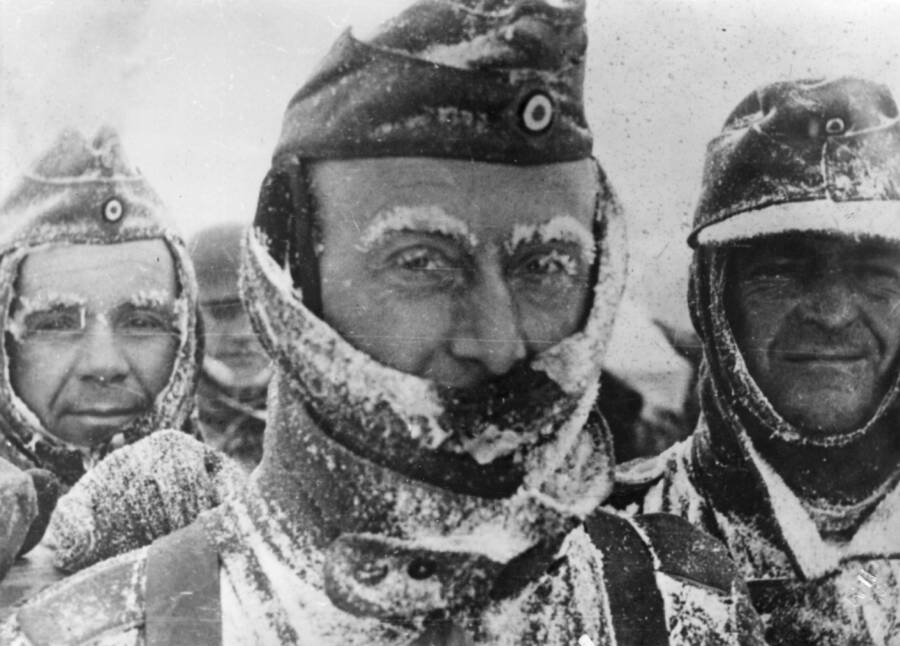
Hulton Archive/Getty ImagesGerman soldiers covered in ice and snow. Eastern Front. March 27, 1944.
Some believe that, if Hitler had kept the momentum going and sent his forces against Moscow, the Soviet Union could have fallen before the end of 1941.
If Hitler’s generals had gotten their way, they would have attacked Moscow in late July of 1941. But instead, Hitler paused, determined to capture and make use of Ukraine’s resources. And, if only for a few weeks, the Soviet Union got the chance to regroup.
The Nazi attack on Moscow didn’t come until November — and by then, the Soviets were ready for them. The Battle of Moscow was a failure, and the Nazi army had to fall back. It was one of their first defeats on the Eastern Front.
Finally, the Red Army had the opportunity to take the offensive.
“Our objective is to deny the Germans any breathing space,” said Soviet Gen. Georgy Zhukov, outlining their plan of attack, “to drive them westward without let-up, to make them use up their reserves before spring comes.”
The Soviets understood that their army had the advantage in winter. As long as a bitter Russian cold slowed the Germans, the Soviets would attack them with all of their might. But when the snow started to melt and spring came, the Red Army would switch to the defensive and only try to slow the German advance.
Hitler refused to budge an inch. No matter how brutally the Red Army attacked, any general who tried to fall back was fired, with Hitler telling them: “Get yourself back to Germany as rapidly as you can – but leave the army in my charge. And the army is staying at the front.”
The Battle Of Stalingrad
As Stalin predicted, in the summer of 1942, Hitler hit back. His target was no longer Moscow — now it was Stalingrad, the strategically vital, weapons-producing city that bore their leader’s name.
The Battle of Stalingrad became the deadliest confrontation of World War II, leaving 2 million people dead.
In that single five-month siege, 1.1 million Soviets would die — nearly three times as many as the Americans would lose in the entire war.
“Not one step back!” was Stalin’s order to the men fighting in Stalingrad; no matter how horrible the battle became, not a single Soviet would retreat even one inch.
That included the some 400,000 civilians living in the city. There was no evacuation. Instead, every Russian strong enough to hold a rifle was ordered to take up arms and defend the city, while the women were sent out to dig trenches at the front lines.
But the men in Stalingrad had seen just how horrific the Nazis could be. They were ready to do anything to keep these monsters from entering their home.
“One sees the young girls, the children, who hang from the trees in the park,” one Soviet sniper said. “This has a tremendous impact.”
Another sniper recalled how the Nazi atrocities kept him fighting after his kill: "I felt terrible. I had killed a human being. But then I thought of our people — and I started to mercilessly fire on them. I've become a barbaric person. I kill them. I hate them."
Millions died, often brutally. Soldiers would recall finding their friends body with their fingernails peeled off, their eyes pulled out, and their skin melted in gasoline and fire.
The fighting was so savage and chaotic that some historians have said the average life expectancy of a Soviet soldier deployed to Stalingrad was only 24 hours.
Still, the Red Army managed to triumph. In time, they circled their forces around the Germans, turning the siege around on them, and starved them out. By the time the Nazis finally surrendered in February of 1943, the city was a hellscape.
Some 100,000 German soldiers were captured at the end of the battle. But by then, there was nothing but hatred left between them.
"They could have easily shot themselves," one Soviet general said with disgust, speaking of the Germans who'd surrendered. "They were such cowards. They didn't have the courage to die."
Of the German soldiers captured, about 5,000 would make it home alive, the vast majority dying in Soviet captivity.
The Battle Of Berlin
The Nazi defeat at Stalingrad was a turning point in the war. It was the first time the Germans publicly admitted defeat.
From then on, the Nazi Army was in retreat. The Red Army slowly retook the Soviet land the Germans had captured and moved onward, closing in on Berlin.
In June of 1944, while American, British, and Canadian troops stormed the beaches of Normandy, the Soviet Army smashed through the German lines on the east.
The war was all but over. Hitler was caught between two armies, and there was no way that he could stop them. But neither side would let it end there.
The Soviets and the Americans alike knew that wherever the Red Army stood at the end of the war would mark the edges of Soviet territory in the days afterward, and so both sides rushed toward Berlin, determined to seize it first.
The Red Army reached the city in April of 1945 — and they were merciless.
Some 100,000 German women were raped during the Battle of Berlin, many by multiple men. An estimated 10,000 of them were raped to death.
"There was no escape," one German would recall. "The second echelon...was the worst. They did all the raping and plundering. They went through all the houses and took whatever they wanted. They stripped homes of every single possession, right down to the toilets."
There was only a handful of German soldiers left to fight them off, and now they knew that they were fighting a futile war, waiting to die without purpose.
One woman who recall watching a young German boy waiting for the Soviet army to approach, not expecting to survive. "He was sobbing and muttering something, probably calling for his mother in despair."
Perhaps Hitler was no different than that young boy. On April 30, 1945, as the Soviet Army entered the center of Berlin, he killed himself inside the Führerbunker.
Two days later, Nazi Gen. Helmuth Weidling officially surrendered to the Soviet forces.
At long last, the horrors of World War II were over.
Death On The Eastern Front Of World War II


Fine Art Images/Heritage Images/Getty ImagesGerman soldiers killed in the Battle of Stalingrad. Stalingrad, USSR. Circa 1943.
"The Eastern Front was a nightmare," one German soldier recalled after the war.
It was the Red Army's sheer ferocity and willingness to die that terrified him. He described them as "suicidal," as men who would willingly throw themselves into machine gun fire just so their bodies would clog the guns.
The armies were merciless. Of the 5.5 million Soviet soldiers the Germans took prisoner over the course of the war, 3.3 million of them died, while 1.1 million Germans died in Soviet captivity.
Some 22 to 28 million Russians and 4 million Germans died on the Eastern Front. It was the site of almost half of the deaths in World War II. By the end, the Soviet Union had lost an estimated 14 percent of its population.
It was one of the greatest losses of life in human history — but without it, the Nazis may never have been stopped.
Without the sacrifice of the men on the Eastern Front, there's no telling how devastating that Holocaust could have been or how far the Third Reich's conquest could have reached.
On Victory Day, one Soviet wrote in his diary that he met a veteran drinking in a bar. He'd been crippled in battle, and he was mourning the friends he'd lost.
Still, the soldier who'd lost everything told his friends: "If there's another war, I'll volunteer again."
After reading about the horrors of the Eastern Front of World War II, check out 33 colorized photos that bring it the Eastern Front's brutality to life. Then, learn about Vasily Zaytsev, the Soviet sniper who inspired the 2001 film, Enemy at the Gates.
